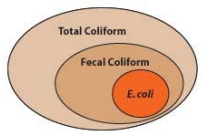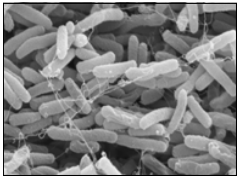Total Coliform and E. coli Bacteria
View/Download PDF Version
 What are Total Coliform and E. coli Bacteria?
What are Total Coliform and E. coli Bacteria?
Total Coliform is a group of bacteria present all around us, most of which are not dangerous to human health. However, these bacteria are not naturally present in groundwater and are an indication that more harmful organisms might be present. Fecal Coliform and E. coli are subgroups within the Total Coliform group which primarily come from the feces of warm blooded animals. Presence of E. coli indicates that the water has been exposed to feces and an immediate risk to human health exists.
Immediate Action to take with a Positive E. coli Test
If E. coli is found present in your water sample, discontinue consumption of the water unless you treat it. Treatment can be achieved by boiling the water for at least one minute. Water should be treated for drinking, making baby formula, washing produce, brushing teeth, and making ice cubes. An alternative to treatment is use of bottled water. Contact your local health department or water quality district about addressing the contamination problem.
Bacteria in Groundwater
If your water sample tests positive for Total Coliform but negative for E. coli there is not an immediate health concern but further investigation is important. If Total Coliform bacteria are reaching the well, more dangerous bacteria may also reach the well so it is important to explore the likely source. Possible explanations include:
- Wells located in gravely or sandy soil where surface water moves quickly down to groundwater
- Wells located too close to a septic system or animal waste source
- Wells located where they can be flooded by runoff or where water flows past the well head
- Wells which are not properly capped and screened to keep out water, animals and insects
- Contamination during well installation or maintenance
- Leaking pipes are allowing bacteria into the supply lines
- A treatment system has not been maintained and is harboring bacteria
- The well is not contaminated but the sample was contaminated during collection
Take an inventory of your system to determine what the likely source of the bacteria is. Address this source to prevent further contamination of your water by more harmful pathogens in the future. If you find your system to be well maintained and free from likely contaminant sources, resample your water for Total Coliform, taking the utmost care to prevent contamination during sampling.
Treating a Well for Bacteria Contamination
If your well water sample tests positive for E. coli, contact your county sanitarian to inquire about what steps to take to address the problem. If there is a source of bacteria reaching your well, chlorinating the system will kill the bacteria in the well but the system will soon be contaminated again. A chlorine solution is the simplest and most effective agent for disinfecting a well, pump, storage tank or piping system. Liquid household bleach is the most commonly available source of chlorine. Regular Purex or Clorox may be used, but DO NOT USE LAUNDRY DETERGENT with bleach added. If shock chlorination is not effective and/or additional bacteria control is desired, an ultraviolet or chlorination disinfection system can be installed to treat for bacteria and other pathogens.
Shock Chlorination of a Private Well Water System
The following instructions are designed to provide assistance in shock chlorinating wells which have been contaminated with bacteria. A video on shock chlorination is also available on the DVD “Taking Care of yOur Ground Water.” The video is viewable on the web at the MSU Extension Water Quality Program website referenced at the end of this web page.
Note:
- During disinfection, your water supply will be chlorinated and not fit for consumption, plan for alternative drinking/cooking water.
Warnings:
- Turn off the power to the pump before removing the well cap to avoid potential electric shock. If you are not familiar with your system, hire a professional well driller to do the job.
- Chlorine may damage some water treatment systems, check manufacturer recommendations before chlorinating a treatment system
Volume of water in one foot of well depth |
||
Well Casing Diameter (inches) |
Water Volume per foot of water depth (gallons) |
|
| 4 | 0.65 | |
| 6 | 1.47 | |
| 8 | 2.61 | |
| 10 | 4.08 | |
| 12 | 5.88 | |
| 18 | 13.22 | |
| 24 | 23.50 | |
| 30 | 36.72 | |
| 36 | 52.87 | |
| Adapted from materials from Wilkes University | ||
Step 1) Calculate how much water you need to treat. You need to determine the amount of water standing in your well which is the total depth minus the depth to groundwater. This information is in your well log which should be available from the driller or from the Montana Bureau of Mines and Geology website (http://mbmggwic.mtech.edu/). Use table 1 to figure out how many gallons of water there are for each foot of water in your well (Example: 50 ft of water with a 6 inch casing = 74 gallons). Add this number to the volume of water in the hot water heater, the pressure tank and the pipes (maybe 10 gallons for a typical house). Round the number of gallons to be treated up to the nearest 50 gallons. You will need 3 pints of liquid laundry bleach (6% sodium hypochlorite) for each 100 gallons of water you are going to treat (Example: 150 gallons requires 4.5 pints of liquid laundry bleach).
Step 2) Using eye protection and rubber gloves, pour the calculated volume of laundry bleach into a five gallon bucket and dilute with water until the bucket is full. Remove the well cap (with power to pump off) and slowly pour the chlorine solution into the well. After inspecting wires to ensure they are in good condition, turn the power to the pump back on.
Step 3) Turn on an outdoor faucet with a hose that will reach the well head. Run the water until you can smell the chlorine at the nozzle. At that point the chlorine is circulating in the system and you can use the hose to disinfect the parts of the well above the water line. After thoroughly washing down the well cap, the inside of the casing, the pitless adaptor and other hardware inside the well, turn off the hose. Now go into the house and separately turn on each faucet until you smell chlorine and then turn it off. Repeat for all cold and warm water faucets.
Step 4) Allow the chlorine solution to remain in the well and service line for 12 to 24 hours.
After disinfection, run an outside faucet (to avoid sending the water to your septic
system) until the odor of chlorine can no longer be detected at the nozzle. Water
should be discharged onto gravel surfaces or areas without vegetation. After clearing
the chlorine from the outside line, similarly run the inside faucets until chlorine can no longer
be detected. Chlorine may release debris from plumbing so you should remove faucet
screens before flushing and check toilet valves for debris after flushing is complete.
It is important to remove the chlorine from the system before using the water for
drinking because household bleach is not appropriate for human consumption.
Step 5) After disinfection, the system should be retested at least 72 hours after the chlorine is cleared from the system to ensure the chlorination was successful.
Additional Resources
Click on the links below to be directed to more resources.
MSU Extension Water Quality Program—Well Educated Program (fact sheets and videos)
US EPA E. coli in drinking water
How to Shock Chlorinate or Disinfect Your Private Water Supply or Water Well
